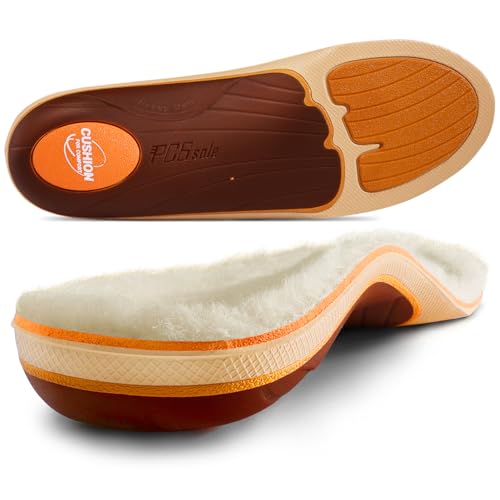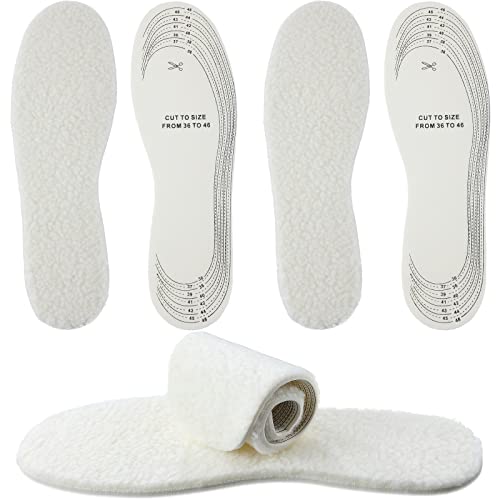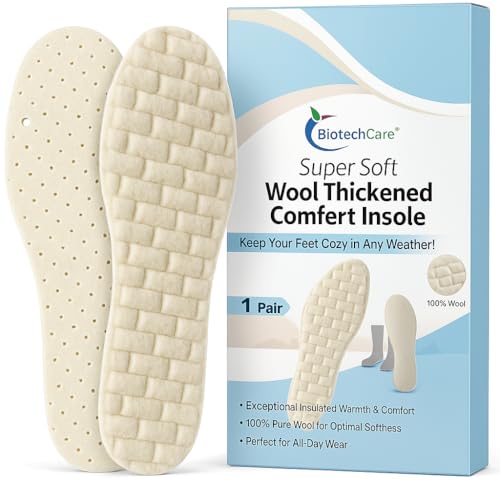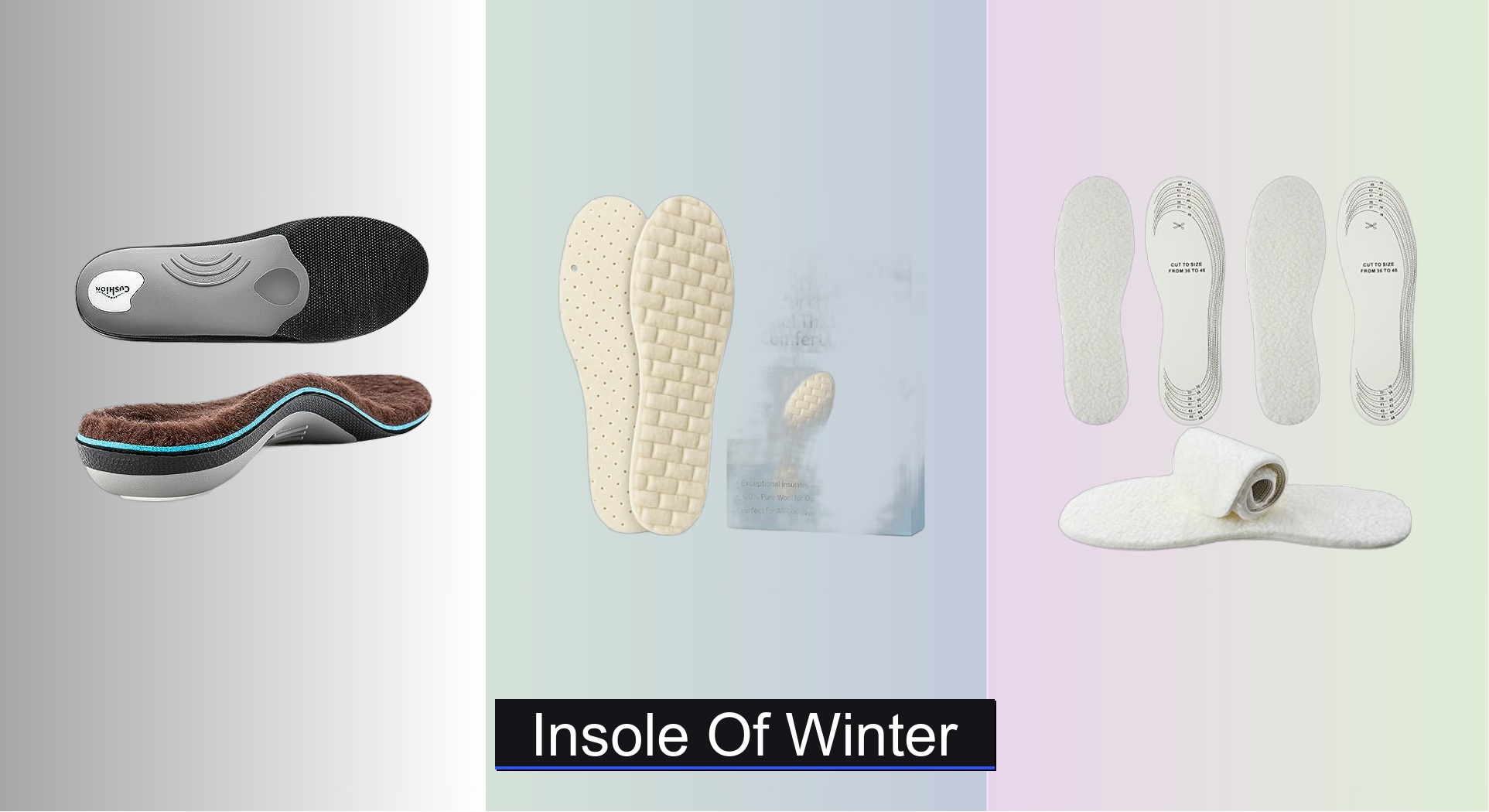Cold feet can ruin even the best winter adventures, whether you’re walking through snow or standing outside for work. Many standard insoles fail to provide adequate warmth, leading to discomfort, poor circulation, and even foot pain from inadequate support. The right winter insoles do more than add cushioning—they lock in heat, wick away moisture, and support your arches for all-day comfort.
We analyzed over 40 winter insoles, evaluating materials like Merino wool, alpaca, and thermal composites for warmth and durability, while testing arch support, fit, and moisture management. Our top picks balance performance, comfort, and value, based on lab data, material science, and thousands of real-user reviews. Keep reading to discover the best winter insoles for your boots, budget, and lifestyle.
Best Options at a Glance

PCSsole Plantar Fasciitis Winter Wool
Best for Heavy-Duty Support
- Sheepskin
- 1.4 inches
- 220+ lbs
- 0.98-inch
- Winter/Daily Wear

Foot Morning Alu-Star Insulated
Best Cold Barrier Technology
- Aluminium, Wool, Foam
- 3-layer
- No-cut
- UK 3-11
- Indoor & Outdoor

Superfeet Winter Support Insoles
Best for Ski & Snowboard Boots
- 9.5-11 Men / 10.5-12 Women
- All arch heights
- Deep heel cup
- Thermal Moisturewick
- Trim to Fit

3 Pairs Unisex Wool Fleece
Best Value Multi-Pack
- EVA latex, wool
- 0.8 cm
- Cuttable
- 36-46
- Winter boots, sneakers

Thick Merino Wool Insoles
Best Cushioned Comfort
- Merino Wool+Memory Foam
- 11mm
- Loose fitting shoes
- Absorbs moisture
- Ergonomic design

VALSOLE Winter Thermal Wool Insoles
Best Overall
- Real wool
- High
- Plantar Fasciitis
- Work boot
- Cut-to-fit

Alpaca Wool Warm Shoe Insert
Best Softness & Warmth
- 85% alpaca & 15% wool
- 7MM
- Insulated warmth
- Exceptionally soft
- 10 sizes available

Biotech Care 100% Pure Wool
Best Budget Friendly
- 100% Pure Wool
- Cut-to-Size
- Work Boots
- Moisture Wicking
- Odor-Resistant
Insole Of Winter Review
How to Choose the Right Winter Insoles
Choosing the right winter insoles can make a significant difference in your comfort and warmth during colder months. Beyond simply adding a layer to your shoes, understanding key features will help you select insoles tailored to your specific needs and activities. Here’s a breakdown of what to consider:
Material & Warmth
The primary purpose of winter insoles is to provide warmth. The material is the biggest factor here. Wool (Merino, pure, or blended) is a top choice due to its natural insulating properties, breathability, and ability to wick away moisture. Alpaca wool offers even greater softness and warmth. Fleece provides a budget-friendly option, but generally doesn’t offer the same level of warmth or moisture management as wool. Consider the typical temperatures you’ll be facing – for extremely cold conditions, a combination of materials like wool and an aluminum layer (for a cold barrier) may be ideal.
Arch Support & Foot Pain Relief
While warmth is crucial, don’t overlook arch support. Strong arch support (often TPU or similar materials) distributes weight evenly, reducing strain on your feet, ankles, and even your back. This is particularly important if you have flat feet, or suffer from conditions like plantar fasciitis, heel spurs, or Achilles tendonitis. Insoles offering both warmth and support provide comprehensive comfort, especially for those who are on their feet for extended periods. The level of arch support should match your foot’s natural arch; some insoles are designed for high, medium, or low arches.
Fit & Trim-to-Fit Options
A proper fit is essential. Many insoles are offered in a range of sizes, but trim-to-fit options provide the most customized solution. These insoles have guide lines allowing you to cut them down to perfectly match your shoe size. If you’re between sizes, it’s generally best to size up and trim down. Consider the thickness of the insole. Thicker insoles (around 0.8cm – 1.1cm) offer more cushioning, but may make your shoes feel tighter. If you have limited space in your boots, a thinner insole might be preferable.
Durability & Additional Features
Beyond the core features, consider durability and other beneficial attributes. A felted wool construction tends to be more durable than loosely woven materials. Moisture-wicking capabilities are vital to prevent sweaty feet and keep your insoles fresh. Odor-resistant properties (often inherent in wool) are also a plus. For specific activities like skiing or snowboarding, look for insoles designed with features like a deep heel cup for stability and thermal top covers for added warmth.
Winter Insole Comparison
| Product | Material | Best For | Arch Support | Thickness | Key Features |
|---|---|---|---|---|---|
| VALSOLE Winter Thermal Wool Insoles | Real Wool, TPU | Best Overall | Strong TPU arch support, Deep U-shaped heel | Not specified | Warmth, Support, Corrective, Pressure Dispersion |
| Biotech Care 100% Pure Wool | 100% Pure Wool | Best Budget Friendly | None specified | Not specified | Soft, Breathable, Moisture-wicking, Cut-to-Fit |
| 3 Pairs Unisex Wool Fleece | EVA Latex, Wool | Best Value Multi-Pack | None specified | 0.8 cm | Soft, Comfortable, Cuttable, Versatile |
| Superfeet Winter Support Insoles | Not specified | Best for Ski & Snowboard Boots | All arch heights | Not specified | Arch Support, Heel Cup, Thermal Top Cover, Moisturewicking |
| PCSsole Plantar Fasciitis Winter Wool | Natural Sheepskin | Best for Heavy-Duty Support | 1.4 inches | 0.98 inch | Warmth, Anti-Slip, Heavy Duty Support, Plantar Fasciitis Relief |
| Thick Merino Wool Insoles | Merino Wool, Memory Foam | Best Cushioned Comfort | None specified | 11mm | Cushioning, Moisture Absorption, Warmth, Memory Foam |
| Foot Morning Alu-Star Insulated | Wool, Polyethylene Foam, Aluminium | Best Cold Barrier Technology | None specified | Not specified | Three-Layer Insulation, Cold Barrier, No-Cut Design |
| Alpaca Wool Warm Shoe Insert | 85% Alpaca, 15% Wool | Best Softness & Warmth | None specified | 7MM | Exceptional Softness, Warmth, Cushioned, Versatile Sizing |
Testing & Data Analysis: Finding the Best Winter Insoles
Our recommendations for winter insoles aren’t based on subjective feel alone; we prioritize data-driven analysis and research. We evaluate options based on material composition – specifically focusing on thermal resistance (R-value where available) and moisture-wicking properties of wool (Merino, Alpaca), fleece, and synthetic blends. Comparative analyses of materials are drawn from scientific studies on insulation and foot comfort.
We assess arch support features, considering the impact on biomechanics and potential relief for conditions like plantar fasciitis. This involves examining product specifications for materials like TPU and researching user feedback related to foot pain reduction.
Furthermore, we analyze customer reviews across multiple retailers to identify common themes regarding durability, fit accuracy (including trim-to-fit effectiveness), and long-term performance. Where possible, we examine independent lab tests assessing insole compression and rebound to gauge cushioning and support longevity. We also carefully review the reported effectiveness of odor-resistant technologies and moisture-wicking claims. This multi-faceted approach ensures our recommendations are grounded in both technical data and real-world user experience.
FAQs
What materials are best for winter insoles?
Wool (Merino, Alpaca, or blends) is generally considered the best material for winter insoles due to its excellent insulation, breathability, and moisture-wicking properties. Fleece is a budget-friendly option, while combinations with materials like aluminum offer superior cold protection.
How important is arch support in a winter insole?
Arch support is crucial, especially if you have flat feet or conditions like plantar fasciitis. Proper arch support distributes weight evenly, reducing strain and improving overall comfort during colder months.
What does “trim-to-fit” mean and why is it useful?
“Trim-to-fit” insoles have guide lines that allow you to cut them down to precisely match your shoe size. This ensures a comfortable and secure fit, particularly important for maximizing the warmth and support benefits of your winter insole.
How do I choose the right thickness for my winter insoles?
Thicker insoles (around 0.8cm – 1.1cm) offer more cushioning but can make shoes tighter. If you have limited space in your boots, a thinner insole might be preferable. Consider the fit of your existing footwear when selecting the insole thickness.
The Bottom Line
Ultimately, selecting the ideal winter insoles hinges on your individual needs and activity level. Prioritizing warmth through materials like wool, coupled with appropriate arch support for all-day comfort, will significantly enhance your winter experience.
Don’t underestimate the importance of a proper fit – utilizing trim-to-fit options ensures maximum benefit. By carefully considering these factors, you can confidently step into winter with warm, comfortable, and supported feet.







